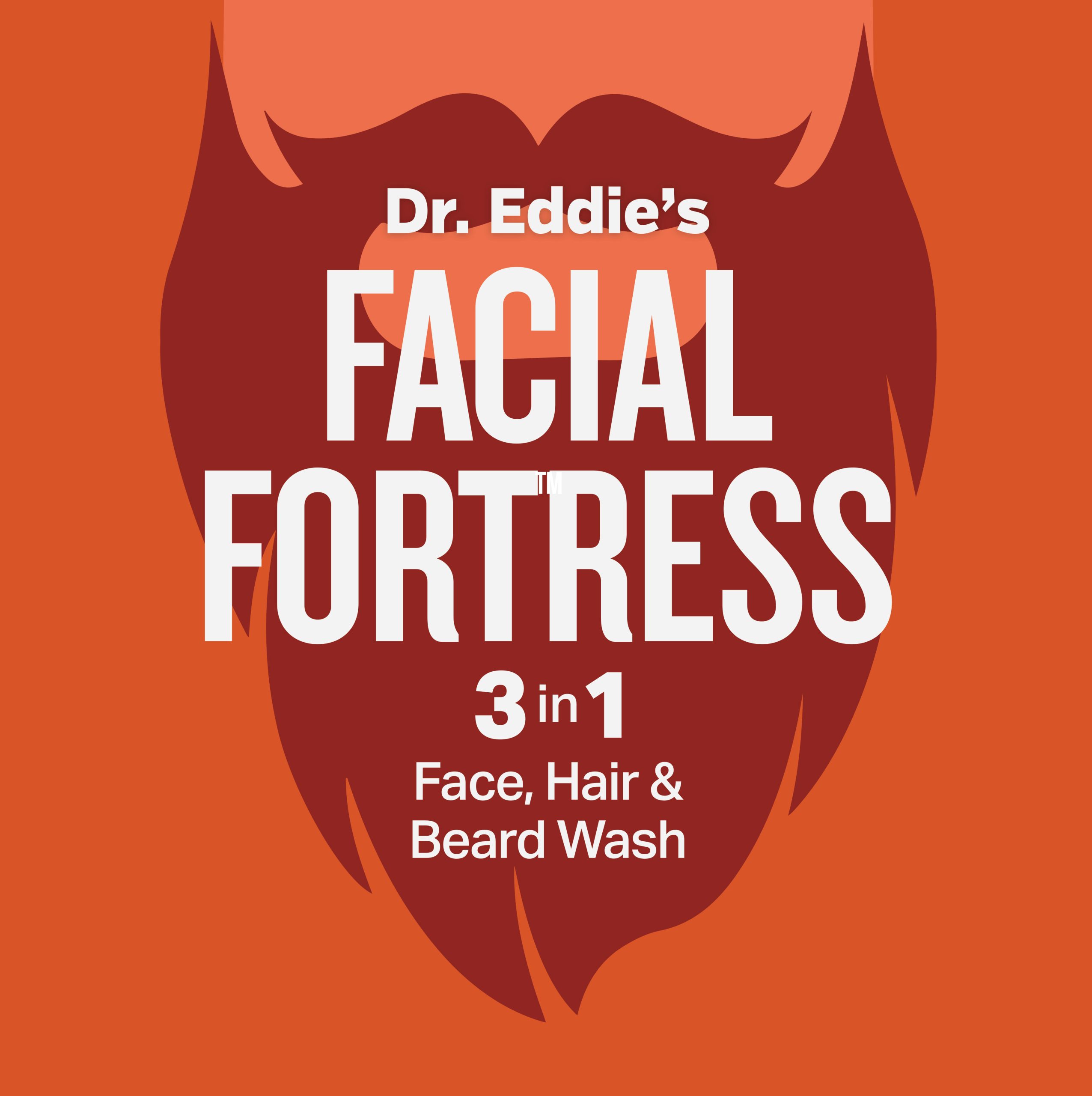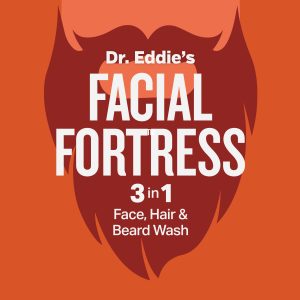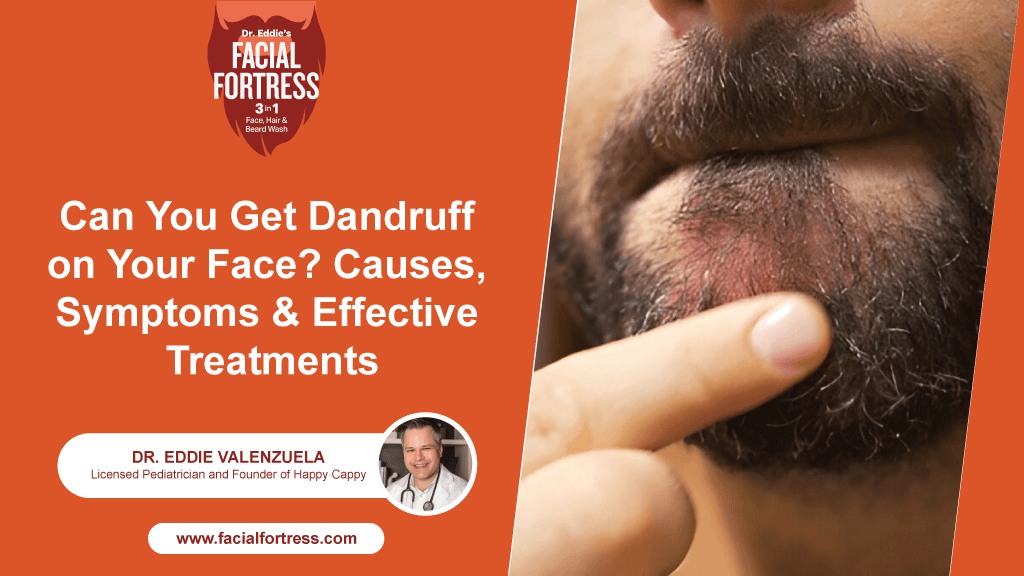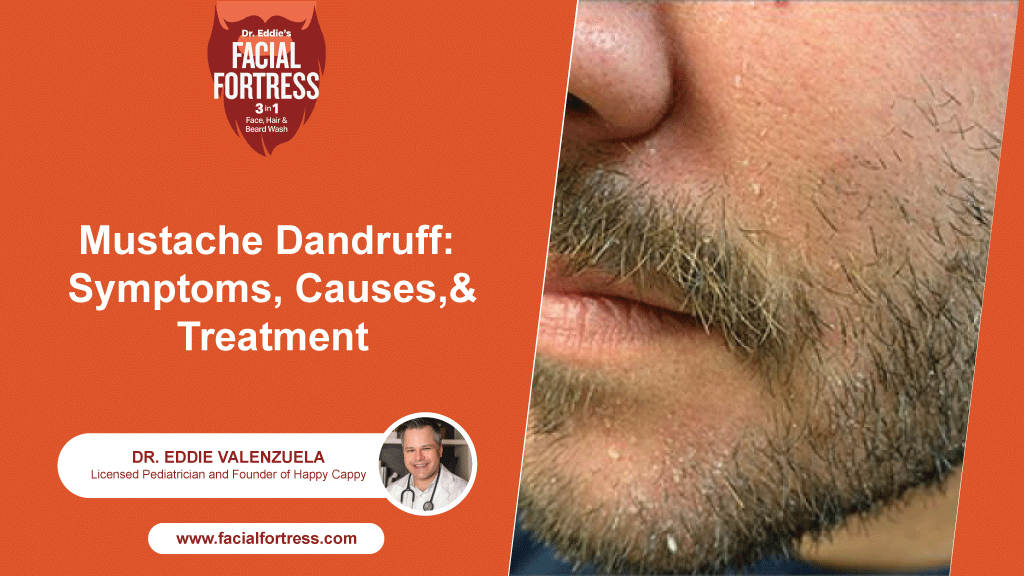Is it Dandruff or Dry Skin? How to Diagnose and Treat Flakes Under Your Beard
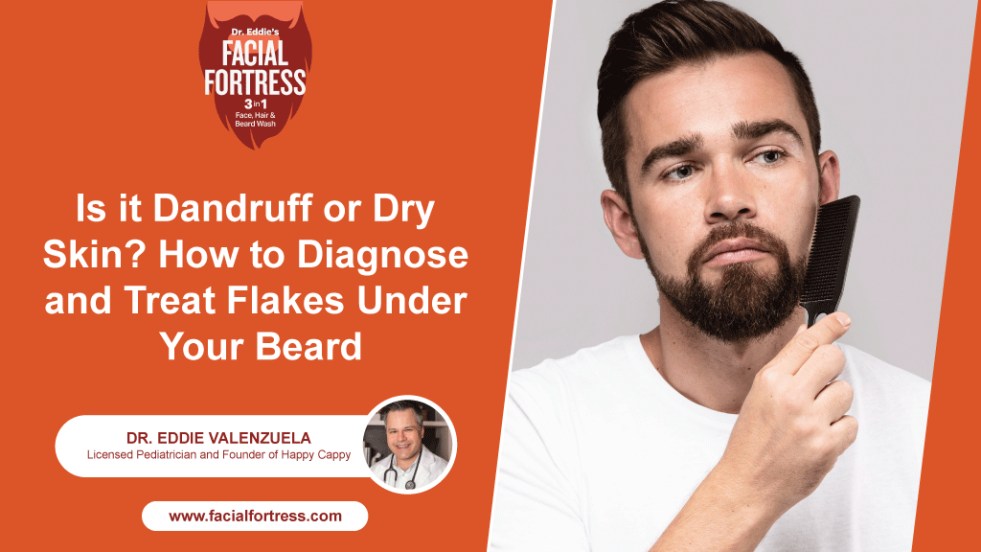
You might be wondering why the skin under my beard is so dry and flaky. Is it due to dandruff? It could be, but that’s not something very straightforward. Dandruff and dry skin are separate conditions with different symptoms, causes, and treatment approaches. This article explains these aspects in detail.
What is Beard Dandruff?
Beard dandruff is simply Seborrheic Dermatitis (SD) on your beard and mustache. SD leads to dandruff in adults and cradle cap in children. In adult males, it can also affect the beard and other facial areas. The skin under the beard may become dry or oily depending on the type of dandruff.
Beard dandruff often happens due to excessive oil production on the skin. However, scalp dandruff is more common than beard dandruff.
What is Dry Skin?
Dry skin under the beard and mustaches is a result of the stripping away of moisture from the skin, making it look dull, dry, or even cracked. This often happens to people in harsh climates or in winter. But it is not a disease. It is an uncomfortable state of the skin which does not require medical attention apart from regular moisturizing.
Dry skin under the beard can also be a result of an underlying skin condition, such as dandruff or eczema. In that case, you first have to diagnose the condition and then get the right treatment. Dry skin is:
- Rough
- Itchy
- Flaky, with small powdery flakes
- Tight
These symptoms can be alleviated with a good moisturizer or oil to smooth the skin.
Dry Skin vs Dry Dandruff
There is also a differentiation between dry skin and dry dandruff. A lack of moisture causes dry skin, while a fungus causes dry dandruff. Dry dandruff has larger and more flakes than dry skin’s small, powdery flakes. Both require different approaches for treatment and prevention. However, one thing is common in their treatment, and that is “moisturizing”.
Key Differences Between Beard Dandruff and Beard Dry Skin
If you have dry, flaky skin under your beard, you must know the three key points to differentiate between dandruff and just dry, itchy skin under your beard.
The first key difference is their symptoms. If the skin under the beard is dry and flaky (with fewer flakes), and no other symptoms except itching, it is just a case of dry, itchy skin under the beard.
If there is oily or dry, red, flaky skin under the beard (with more and larger flakes), but the skin is also irritated, very itchy, or the beard has small hairless patches, it is beard dandruff. Beard dandruff can be oily dandruff or dry dandruff, depending on the person, skin type, climate, etc. However, oily dandruff is more common.
The second key difference lies behind their causes. Beard dandruff, whether with dry or oily flakes, is often caused by a fungus (Malassezia) or environmental factors. On the other hand, dry skin can be caused by a lack of moisture or an underlying medical condition.
And the third point is the difference in treatment. If dry and flaky skin under the beard is not improving with a good oil or moisturizer, it is a case of dandruff that requires a potent but gentle anti-dandruff shampoo for treatment. To soothe dry skin under the beard, you need to ensure adequate moisturizing to the affected skin.
These are some ways that allow for a crystal clear understanding of dandruff vs dry skin.
Signs Your Beard Flakes Are from Dandruff
- Flakes are oily and big
- Flakes are yellowish
- Greasiness on the hair, along with the oily flakes
- Flakes persist or worsen after moisturizing
- Flakes have an unpleasant smell (oily smell)
- Flakes need cleansing for smooth removal
Signs Your Beard Flakes Are from Dry Skin
- If flakes are powdery and very small in size
- Flakes are white
- The skin is dry or even cracked
- Flakes go away after moisturizing
- Flakes are dry
- Flake quantity is small
Causes of Beard Flakes
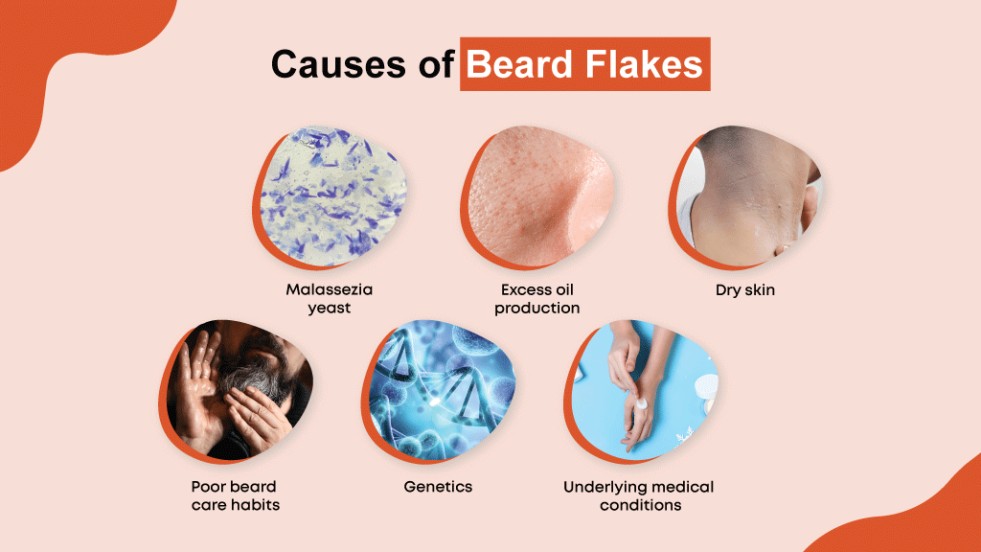
There is no exact cause of beard flakes, but certain factors are more likely to increase flakiness under your beard.
Malassezia yeast
This is considered the primary cause of all types of dandruff. The growth of this yeast increases the consumption of sebum oil and produces the irritant oleic acid. That acid results in inflammatory reactions and the buildup of dead cells, causing flake formation. If Malassezia is the leading cause of flakiness on the skin, it can also be known as fungal dandruff.
Excess oil production
If your skin is oily, it will create a favorable environment for the fungus to thrive. Thus, resulting in the formation of flakes.
Dry skin and harsh weather
Dry skin and dandruff are both separate conditions, but dryness can lead to flakes under the beard. In winter, the skin becomes dry and more prone to developing flakes. The skin becomes vulnerable and sensitive. This also increases the buildup of dead skin cells, resulting in flakes.
Poor beard care habits
Poor hygiene is not a significant factor, but it is still important. Inadequate care can result in a weakened skin barrier, which can lead to an increased buildup of dead cells. Plus, the use of harsh products can trigger allergic reactions in your skin, resulting in dry, flaky skin under the beard.
Genetics and skin sensitivity
Genetics plays a key role in beard dandruff. If there is a family history of eczema and psoriasis, future generations are more likely to develop cases of Seborrheic Dermatitis. Genetics also plays a role in the occurrence of dandruff on the beard and scalp.
Underlying medical conditions
Existing medical conditions can lead to or exacerbate dandruff. Dry skin, a skin condition in itself, can lead to dry dandruff or exacerbate it. Stress, medication, eczema, and hormonal imbalance can also cause dryness and flakes under the beard.
How to treat Seborrheic Dermatitis in your beard?
Anti-dandruff shampoo
Want to know how to handle seborrheic dermatitis under beards? Well, an anti-dandruff shampoo, containing pyrithione zinc as an active ingredient and infused with natural ingredients, and lacking in drying ingredients is the right choice for you. It will soothe redness, remove flakes, and reduce itching and irritation. Plus, it may soften the beard and increase its growth. So, with the right dandruff shampoo, you are not just getting treatment, you are also attending to the appearance of the beard. The medicated wash by Facial Fortress is suitable for individuals with sensitive skin and can be used on the face, beard, and scalp.
How to Treat Dry Skin Under Your Beard
Using a gentle, hydrating cleanser
Dry skin is not a serious issue and is pretty common. It can be easily soothed with a gentle, irritant-free cleanser. Use an irritant free moisturizer following the hydrating cleanser for better results. This will cleanse the underlying skin, and the moisturizing cream will lock in moisture.
Applying beard oils
Beard oils work well in moisturizing the skin and softening the hair. They can be highly beneficial for addressing dryness, itching, and redness on the skin. However, you must be careful with the choice of product. Not all oils are created equally. Do your research and find the one that keeps the balance between effectiveness and prevention from harmful ingredients. Apply the oil regularly and rinse after a few hours. Use the oil daily, and the results should appear in a few days to a week.
A single solution for two conditions

If you have dandruff on your scalp and flakes in your beard, then you likely have beard dandruff. How nice would it be to have a single potent yet gentle solution for both problems? The 3-in-1 medicated wash by Facial Fortress is a great solution for dandruff and seborrheic dermatitis occurring anywhere on your head. No matter whether you have oily or dry dandruff, it cleanses the skin and eliminates flaking associated with dandruff and seborrheic dermatitis. The shampoo can be applied to the face, hair, and beard. Facial Fortress is gentle because it avoids the common drying irritants known as sulfates, and does not contain parabens, fragrance and dyes. Soften your beard and fight flakes!
When to Seek Medical Help
Here are some key indicators that help you understand when to consult a professional for your condition.
- Severe redness, swelling, or infection
- Flakes are not improving despite treatment
- Symptoms pointing to eczema or psoriasis
- Skin under the beard has cracks or bleeding
- Oozing patches on the skin
Conclusion
There are key differences between beard dandruff and dry skin under the beard. One should know how to evaluate both existing conditions to approach them safely, as different factors cause each and require separate treatment. Dr. Eddie’s 3-in-1 Medicated Wash is a single gentle solution that can be applied safely to the skin, beard or hair on the scalp. It not only helps target the symptoms associated with dandruff and seborrheic dermatitis, but also softens the beard.
- Malassezia Yeast and Beard Seborrheic Dermatitis: A Complete Management Guide - October 28, 2025
- Can You Get Dandruff on Your Face? Causes, Symptoms & Effective Treatments - September 30, 2025
- Is it Dandruff or Dry Skin? How to Diagnose and Treat Flakes Under Your Beard - September 16, 2025
Recent Post
Frequently Asked Questions
Will shaving off the beard cure dandruff?
Shaving would remove flakes temporarily, but it does not treat dandruff itself. There are associated symptoms such as oiliness or dryness, itchy beard, irritation, and redness that need to be dealt with. Therefore, dandruff needs the appropriate solution, not shaving the beard. And when you get the appropriate treatment, you don’t need to get rid of your beard. Instead, a medicated shampoo for your beard will eliminate the scaling, flaking, itching, and redness on the scalp and skin associated with dandruff and seborrheic dermatitis and may improve the appearance of the beard as well.
Can beard dandruff cause hair loss?
Is there any difference between dry skin and dry dandruff?
Does beard oil stop beard dandruff?
- Malassezia Yeast and Beard Seborrheic Dermatitis: A Complete Management Guide - October 28, 2025
- Can You Get Dandruff on Your Face? Causes, Symptoms & Effective Treatments - September 30, 2025
- Is it Dandruff or Dry Skin? How to Diagnose and Treat Flakes Under Your Beard - September 16, 2025
